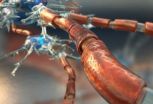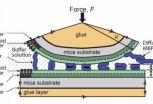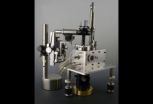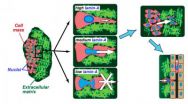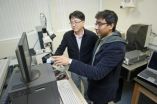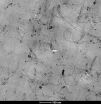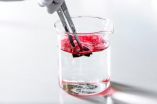(Press-News.org) (Santa Barbara, Calif.) — Using the surface forces apparatus and an atomic force microscope, researchers at UC Santa Barbara have taken a molecular approach to myelin membrane interactions, leading to insights into demyelinating diseases, such as multiple sclerosis. Their research is published in the Proceedings of the National Academy of the Sciences.
For a healthy nervous system, axons — the long projections of our nerve cells that run throughout our bodies — must be properly insulated. Much like conventional power cords need electrical insulators around the conducting wires for efficient and effective transfer of current, axons rely on multiple bilayers of myelin to maintain a rapid and optimal transfer of impulses between, for instance, brain and organ, or spinal cord and muscle. These bilayers are composed of lipids (fat molecules), protein and water.
"Basically, myelin is this multiple stacking of lipid bilayers," said Dong Woog Lee, a researcher in UCSB's Department of Chemical Engineering, and the study's lead author. "They need to be compact, and with very little water between the bilayers."
However, even the slightest change in the composition of these myelin bilayers to affect their ability to insulate axons, the researchers found. To observe and measure the characteristics and differences between healthy and diseased myelin bilayers, they studied the ability of these layers to adhere to each other.
On each of the two opposing surfaces of the surface forces apparatus — a highly sensitive instrument that can measure interactions between membranes — the researchers deposited a lipid bilayer on a mica substrate. Then they immersed the setup in a buffer solution containing myelin basic protein (MBP), a biomolecule commonly found in myelin that gives them adhesive properties and plays a role in maintaining the optimal structure of the myelin sheath. They brought the two bilayers close together, allowing them to stick to each other, and then pulled them apart, measuring the strength of the adhesion brought about by the MBP "glue" between the bilayers, and also the MBP's adsorption — the ability of the MBP molecules to stick to the bilayers' surfaces. They performed this experiment with both healthy myelin and with "disease-like" myelin bilayers.
"A lipid bilayer simulating a normal or healthy myelin membrane adsorbs this protein much better than a lipid bilayer simulating a multiple sclerosis-type of myelin membrane," said UCSB researcher Kai Kristiansen, "meaning that the protein attaches more strongly to the lipid bilayer and can make two apposing lipid bilayers adhere more firmly to each other and at a smaller distance — which is highly desirable for a well functioning myelin around a neuron."
One common characteristic of diseased myelin is swelling, due to various causes such as the autoimmune responses associated with MS and its variants, or in cases of infection or exposure to certain chemicals. Genetics also play a role in the health of myelin.
"When the disease progresses, people can see that they swell and eventually vesiculate, creating scars," said Lee. The MBP layer between the lipid bilayers also swells with water that seeps in between the double lipid layers. Instead of being a compact, molecule-thick film, the MBP layer becomes more gel-like.
"And since there's more water between the bilayers, their insulation property decreases," added Lee. From there, impulses slow down along the axon, or dissipate before they reach their destinations, causing paralysis and loss of function.
Disease–related changes in the lipid domain structures' size and distribution also causes irregular adsorption of MBP onto the lipid bilayers and weakens their adhesion properties, leading to lower nerve insulation. This in turn also leads to lower nerve insulation.
The molecular study of healthy and diseased myelin bilayers differs from conventional genetic, cellular or immunological approaches and may provide future insights into causes and mechanisms of demyelinating diseases.
The next step, according to Jacob Israelachvili, professor of chemical engineering and of materials at UCSB, is to develop a user-friendly bench-top instrument that could be used in hospitals and clinics to visualize the membranes of certain cells, both healthy and pathological, whose domain structure can be an indicator of the progression of a disease.
"We are currently planning a collaboration with a local hospital to provide us with such membranes, for example, from leukemic blood cells, that we would tag with a suitable fluorescent dye to enable this imaging," he said.
INFORMATION: END
Unhealthy attachments
2014-02-25
ELSE PRESS RELEASES FROM THIS DATE:
Penn researchers show nuclear stiffness keeps stem cells and cancer cells in place
2014-02-25
Adult stem cells and cancer cells have many things in common, including an ability to migrate through tiny gaps in tissue. Both types of cells also experience a trade-off when it comes to this ability; having a flexible nucleus makes migration easier but is worse at protecting the nucleus' DNA compared to a stiffer nucleus. Nuclear proteins that regulate nuclear stiffness are therefore thought to control processes as diverse as tissue repair and tumor growth.
In a study published in the Journal of Cell Biology, researchers at the University of Pennsylvania have shown ...
Climate engineering: Minor potential, major side effects
2014-02-25
Despite international agreements on climate protection and political declarations of intent, global greenhouse gas emissions have not decreased. On the contrary, they continue to increase. With a growing world population and significant industrialization in emerging markets such as India and China the emission trend reversal necessary to limit global warming seems to be unlikely. Therefore, large-scale methods to artificially slow down global warming are increasingly being discussed. They include proposals to fertilize the oceans, so that stimulated plankton can remove ...
Breast-feeding benefits appear to be overstated, according to study of siblings
2014-02-25
COLUMBUS, Ohio – A new study comparing siblings who were fed differently during infancy suggests that breast-feeding might be no more beneficial than bottle-feeding for 10 of 11 long-term health and well-being outcomes in children age 4 to 14.
The outlier was asthma, which was associated more with breast-feeding than with bottle-feeding.
The study also included an analysis of outcomes across families of different races and socioeconomic circumstances for comparison purposes, and those results matched other studies suggesting that breast-feeding's benefits to children ...
Smartphone-based voting technology may lead to fewer user errors
2014-02-25
Many U.S. counties have incorporated electronic voting technology, largely in response to well-publicized challenges related to older mechanical and punch-card models. Although these updated systems have solved some usability problems, they present a new set of issues for voters unfamiliar with the technology. A new study published in Human Factors examines how smartphone-based voting systems can be incorporated into the current large-scale election process.
"Current electronic voting systems have numerous issues - from usability and accessibility to security to the ...
New approach to chip design could yield light speed computing
2014-02-25
Every second, your computer must process billions of computational steps to produce even the simplest outputs. Imagine if every one of those steps could be made just a tiny bit more efficient. "It would save precious nanoseconds," explained Northeastern University assistant professor of physics Swastik Kar.
Kar and his colleague Yung Joon Jung, an associate professor in the Department of Mechanical and Industrial Engineering, have developed a series of novel devices that do just that. Their work was published recently in the journal Nature Photonics.
Last year, the ...
Geology covers Mars, the Moon, anthropogenic lead poisoning, earthquake hazards, and more
2014-02-25
Boulder, Colo., USA – The Geological Society of America's top journal, Geology, displays its multidisciplinary best in this latest posting. Earth science disciplines covered include geoarchaeology, climatology, invertebrate paleontology, sedimentology, geomorphology, seismology, planetary geology, geochemistry, glaciology, plate tectonics, mineralogy, and environmental and medical geology. Locations include Mars; Earth's moon; India; the Tibetan Plateau; the Saskatchewan River; L'Aquila, Italy; the Antarctic; Australia; the Andes; the San Andreas fault system; and Kume ...
Scientists twist sound with metamaterials
2014-02-25
WASHINGTON D.C. Feb. 25, 2014 -- A Chinese-U.S. research team is exploring the use of metamaterials -- artificial materials engineered to have exotic properties not found in nature -- to create devices that manipulate sound in versatile and unprecedented ways.
In the journal Applied Physics Letters, the team reports a simple design for a device, called an acoustic field rotator, which can twist wavefronts inside it so that they appear to be propagating from another direction.
"Numerous research efforts have centered on metamaterial-based devices with fascinating wave-control ...
Improvement in polymers for aviation
2014-02-25
We live surrounded by polymers and today, rather than come up with new polymers, there is a tendency to modify them in order to obtain new applications. Carbon nanotubes have excellent mechanical properties, are very tough, very rigid, and what is more, they conduct electricity. "The problem with them is that they get dispersed, in other words, it's very difficult to get them to blend with polymers," explained Iñaki Eguiazabal, a member of the Polymer Technology Group. That is why it is essential to come up with methods that will enablethe carbon nanotubes to have a ...
'Greener' aerogel technology holds potential for oil and chemical clean-up
2014-02-25
MADISON, Wis. – Cleaning up oil spills and metal contaminates in a low-impact, sustainable and inexpensive manner remains a challenge for companies and governments globally.
But a group of researchers at the University of Wisconsin–Madison is examining alternative materials that can be modified to absorb oil and chemicals without absorbing water. If further developed, the technology may offer a cheaper and "greener" method to absorb oil and heavy metals from water and other surfaces.
Shaoqin "Sarah" Gong, a researcher at the Wisconsin Institute for Discovery (WID) ...
Glycerol phenylbutyrate reduces hepatic encephalopathy events
2014-02-25
Phase 2 trial results published in the March issue of Hepatology, a journal of the American Association for the Study of Liver Diseases, suggests the potential for Glycerol Phenylbutyrate (GPB) to reduce hepatic encephalopathy episodes in patients with cirrhosis, with a safety profile similar to placebo.
Patients with hepatic encephalopathy experience neuropsychiatric symptoms that may range from mild confusion to coma. There is conflicting evidence on the link between elevated blood ammonia and hepatic encephalopathy. Poorly-absorbable disaccharides and antibiotics ...
